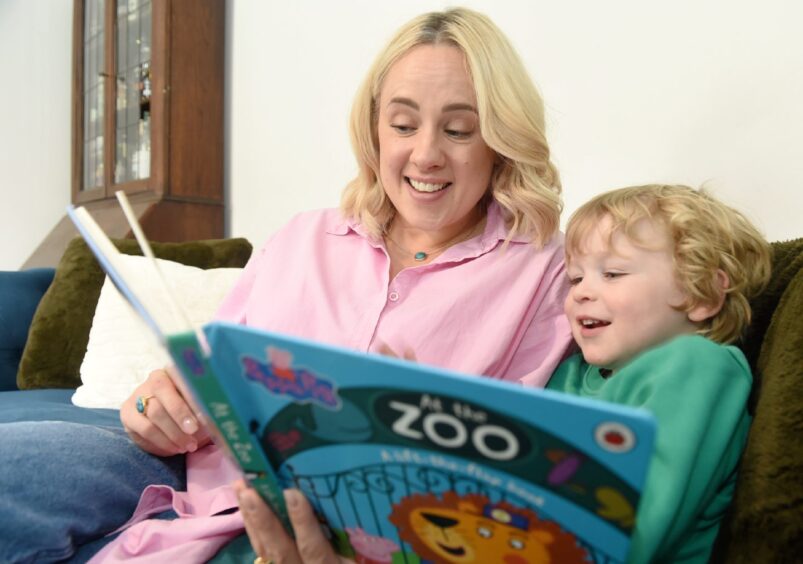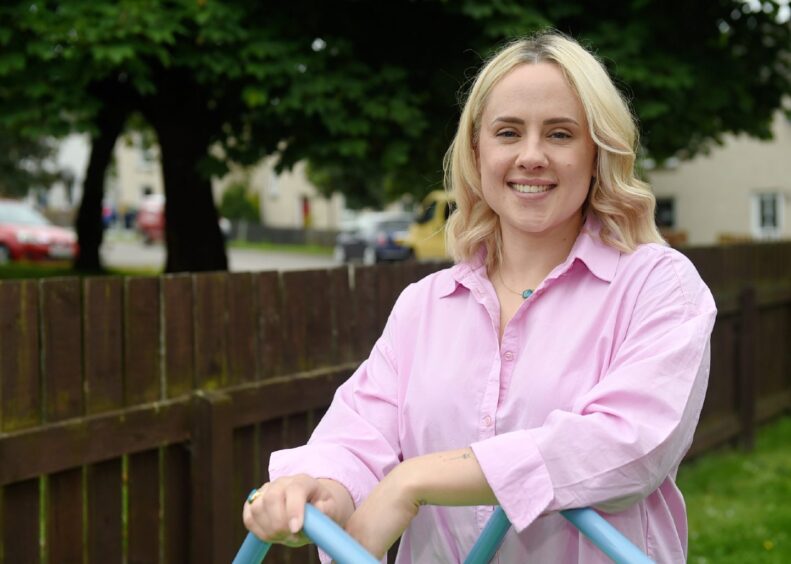
When Skye Jolly decided to become a childminder, she did it out of necessity.
With no nearby childcare services after moving to Aberlour in Moray, she could not return to work for the NHS and set out on a new path.
But she is far from the only parent facing a dilemma over childcare.
More than a third of childcare services in Shetland and the Western Isles have been lost since 2017.
Moray had the smallest decrease in the north and north-east with -14.4% and saw a recent rise.
The Highlands saw a 32% decrease followed by a fall of 27% in Aberdeenshire and 23.6% in Aberdeen over seven years.
The regulatory body tracks childcare across three different categories: childcare agencies, day care of children and childminding.
Day care of children covers childcare taking place in a centre-based facility such as nurseries, playgroups and afterschool clubs. Meanwhile, childminders deliver care from their home.
Childcare agencies are the smallest category and supply carers to look after children in the family’s home.
We have launched trackers to allow readers to access crucial information on the standards of care homes and childcare services in their area.
The analysis highlighted a considerable decline in the number of childcare services.
However, the largest source of the decline is a fall in childminders.
The shrinking number of childminders
The net number of childminders registered with the Care Inspectorate fell from 5,344 in June 2017 to 3,043 in 2024.
Dropping from 16 to just four, Shetland Islands saw the biggest percentage fall in childminders anywhere in Scotland with -75%.
It is followed by Na h-Eileanan Siar which loss over half with -58.3%.
Highlands dropped from 297 childminders in 2017 to 161 in 2024 or a 45.8% decline.
Aberdeen saw services decline by 33.7%, while Aberdeenshire saw a bigger drop with 36.2%.
But even though Moray had the smallest percentage decline of any local authority, when Skye Jolly started her childminding business in 2022 she had families waiting before she even finished registration.
“I think because it was a rural area and there was a big need for it, it was quite easy for me,” she said.
“I had people waiting three or four months until all my certificates came through and I literally got it all sorted on the 1 of November and started the next day.”
And the necessity started at home, she said: “When it came to thinking of actually going back to work, I realised there were absolutely no childcare options.
“None whatsoever. The one or two people within driving distance were already full.
“I did think well there is a bit of a gap in the market, and I can’t go back to what I was doing so why not try?”
What is behind the decline?
The Scottish Childminding Association (SCMA) has recently expanded its efforts to boost childminding recruitment and retention with the launch of a three-year funded programme.
The Programme for Scotland’s Childminding Future hopes to recruit 1,000 childminders in the next three years.
Chief executive Graeme McAlister said the workforce has been declining since 2016.
“What we have seen is a decrease in those coming into the workforce and an increase in those leaving,” he said. “We recognised the need to take action some years ago.”
An ageing workforce, a lack of recruitment and the challenges associated with the expansion of funded early learning and childcare (ELC) are just some of reasons behind the fall, according to the chief executive.
“We have had an ageing workforce”, the chief executive added.
“What we found when we analysed the data was that one in four were aged 55 plus.
“Childminding itself hadn’t really been promoted as a career so there had also been a decline in new registrations or childminders coming into the workforce.”
He explained that the expansion of ELC in 2016 saw staff leave private nurseries and childminding for the higher local authority rates rather than bring new recruits into the industry.
“It had the unintended consequences of destabilising the industry at that time.”
What about day care of children?
Nurseries and other childcare services based in official facilities are categories as day care of children services by the Care Inspectorate.
In 2017, the number of childminders outnumbered these services by almost 2,000.
In June of this year, there were 3,373 day care services compared with 3,043 childminding services.
But day care services still saw an 8.7% decline over the seven years.
The biggest decline was in the Western Isles with -18.5%, followed by Shetland.
However, unlike childminding, there are some local authorities in Scotland that have increased the number of these services.
Where are there less services?
After launching a three-year strategy in 2021, SCMA has successfully recruited and set up over 80 new childminders in different parts of Scotland.
This involved work with local authorities across Scotland but particularly those in rural and remote areas, such as Highland council.
New approaches to recruitment, with a focus on targeted digital marketing, were trialled in rural areas before being expanded to urban.
The SCMA chief executive said: “Childminders themselves, particularly in rural areas, become a really valued community asset. It is a local resource.”
Speaking on how “acute the childcare situation is in rural areas”, Graeme said: “You have parents driving 40 miles to access childcare.
“We were very aware of that and these remote rural local authorities wanted our help.
“What we did with the rural pilot is to engage more closely with local authorities and look at areas where there was a really acute demand for childcare.”
The map below shows the rate of childcare services per 1000 in reference to data zones.
These geographic regions split Scotland up into population areas of 500 to 1,000 household residents.
So urban areas with denser populations will split into smaller geographic areas.
The map shows a lower density of childminding services in rural areas than day care services such as nurseries.
The distribution of day care services is also more consistent throughout the rural data zones.
‘A very high quality form of childcare’
Another reason for the decline in childminding according to the SCMA chief was a misperception of the career itself.
“What many people don’t realise is that childminding is a registered form of childcare.
“Childminders year on year achieve higher ratings across all quality criteria through independent inspection of the Care Inspectorate than day care of children services.
“Childminding is a very high quality form of childcare but those misperceptions are affecting things as well.”
Even Skye admitted that she held some misperceptions herself.
“I don’t think I would have put my own children to a childminder before becoming one myself,” she said.
“I didn’t really understand the concept of ‘so I just drop my child off at someone’s house’. It was always a bit like how does that work?
“How do they get the support and the educational sides of things. I always thought it was a bit of glorified babysitter.
“But now doing it myself, no, it is really not,” she added resolutely.
Inspectors hold childminders to the same standards as day care services. But, they must complete the administrative work in their own time.
The Scottish Government has committed the Care Inspectorate and Education Scotland to create a single framework for quality inspection to streamline duplicated work.
Childminding still outperforms day care of children services in some of the Care Inspectorate grading categories known as key questions.
Childminding services on average outperform day care of children in the setting and play and learning categories.
These are both led by the local authorities with a handful of childminding services. Shetland and the Western Isles had the highest averages.
Can we reverse the trend?
The Programme for Scotland’s Childminding Future will see the recruitment programme now scaled up across the country.
Half of Scotland’s local authorities, including Aberdeenshire and Aberdeen City, are participating.
It includes initiatives such as funded time off the floor to allow childminders time to carry out paperwork and training.
These are among some of the steps to ensure retention also increases alongside recruitment.
Even Skye intended for her childminding venture to be temporary.
“To be honest, I was thinking this would be just a temporary thing until my own child went to nursery,” she said.
“Now he has started nursery and I think well we can keep going.”
She added: “It was really easy for me to get started and I have been really lucky in that sense.”
But she added that a network of nearby childminders and the SCMA have helped her tackle hurdles on the way.
The SCMA chief added: “Historically, childcare has been perceived as quite low level.
“It is hugely important for child development, learning, care and nurture.
“But in practical terms, childcare enables parents to work, to seek work and to stay in work and that is massively important to families.
“At a national level, people are actually recognising that without childcare you have big problems.”
Where can I find more?
We have launched two new trackers that bring you the latest data on the performance of childcare services and care homes.
The childcare tracker allows you to both compare and contrast specific services as well as track performance on local authority levels.
Our care home tracker collates data for all of Scotland’s care homes. But there is also added analysis for Aberdeen, Aberdeenshire, Highlands, Moray, Shetland, Orkney and the Western Isles.



Conversation